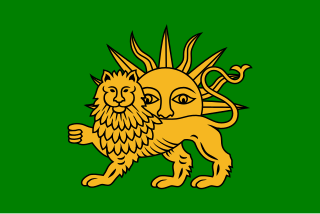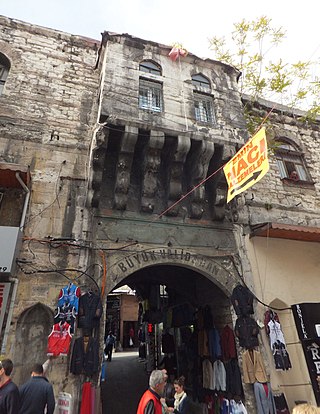
The Arg-e Bam, located in the city of Bam, Kerman Province of southeastern Iran, is the largest adobe building in the world. The entire building was a large fortress containing the citadel, but because the citadel dominates the ruins, the entire fortress is now named Bam Citadel.

A caravanserai was a roadside inn where travelers (caravaners) could rest and recover from the day's journey. Caravanserais supported the flow of commerce, information and people across the network of trade routes covering Asia, North Africa and Southeast Europe, most notably the Silk Road. Often located along rural roads in the countryside, urban versions of caravanserais were also historically common in cities throughout the Islamic world, and were often called other names such as khan, wikala, or funduq.

Iranian architecture or Persian architecture is the architecture of Iran and parts of the rest of West Asia, the Caucasus and Central Asia. Its history dates back to at least 5,000 BC with characteristic examples distributed over a vast area from Turkey and Iraq to Uzbekistan and Tajikistan, and from the Caucasus to Zanzibar. Persian buildings vary greatly in scale and function, from vernacular architecture to monumental complexes. In addition to historic gates, palaces, and mosques, the rapid growth of cities such as the capital Tehran has brought about a wave of demolition and new construction.

Naqsh-e Jahan Square, also known as the Shah Square prior to 1979, is a square situated at the center of Isfahan, Iran. Constructed between 1598 and 1629, it is now an important historical site, and one of UNESCO's World Heritage Sites. It is 160 metres (520 ft) wide by 560 metres (1,840 ft) long. It is also referred to as Shah Square or Imam Square. The square is surrounded by buildings from the Safavid era. The Shah Mosque is situated on the south side of this square. On the west side is the Ali Qapu Palace. Sheikh Lotf Allah Mosque is situated on the eastern side of this square and at the northern side Qeysarie Gate opens into the Isfahan Grand Bazaar. Today, Namaaz-e Jom'eh is held in the Shah Mosque.

An Iranian architect is traditionally called a mi'mar.
The Russo-Persian Wars or Russo-Iranian Wars were a series of conflicts between 1651 and 1828, concerning Persia (Iran) and the Russian Empire. Russia and Persia fought these wars over disputed governance of territories and countries in the Caucasus. The main territories disputed were Aran, Georgia and Armenia, as well as much of Dagestan – generally referred to as Transcaucasia – and considered part of the Safavid Iran prior to the Russo-Persian Wars. Over the course of the five Russo-Persian Wars, the governance of these regions transferred between the two empires. Between the Second and Third Russo-Persian Wars, there was an interbellum period in which a number of treaties were drawn up between the Russian and the Persian Empires, as well as between both parties and the Ottoman Empire. Ottoman interest in these territories further complicated the wars, with both sides forming alliances with the Ottoman Empire at different points throughout the wars. Following the Treaty of Turkmenchay, which concluded the Fifth Russo-Persian War, Persia ceded much of its Transcaucasian territory to the Russian Empire.

Jamshid Bahman Jamshidian, also known as Arbab Jamshidi, was a prominent Zoroastrian figure in Iran who introduced the idea of modern banking in Iran as well as being the first representative of the Zoroastrian community in the Iranian Parliament.
The city of Shiraz, Iran is more than 4000 years old.

A ribāṭ is an Arabic term, initially designating a small fortification built along a frontier during the first years of the Muslim conquest of the Maghreb to house military volunteers, called murabitun, and shortly after they also appeared along the Byzantine frontier, where they attracted converts from Greater Khorasan, an area that would become known as al-ʻAwāṣim in the ninth century CE.

Rab'-e Rashidi is the site of a historic building complex including a school and a workshop for producing books that was constructed in the early 14th century during the reign of Ghazan, a ruler of the Ilkhanid dynasty, in the northeastern part of the city of Tabriz, Iran. Other buildings later replaced these, and the site is now ruined, but it is the original complex that gives the site its fame. It was founded and richly endowed by Rashid al-Din Hamadani, the chief minister of Ghazan Khan. Rashid al-Din sought to gather the most famous intellectuals of his time in fields of philosophy, science and medicine. The establishment began to decline after the execution of Rashid al-Din in 1318, though his son Ghiyas al-Din ibn Rashid al-Din led a revival in the 1330s until his own murder in 1336.

The Ganjali Khan Complex is a Safavid-era building complex, located in the old center of city of Kerman, Iran. The complex is composed of a school, a square, a caravanserai, a bathhouse (hammam), an Ab Anbar, a mint, a mosque and a bazaar.

Kharanaq, also Romanized as Kharānaq, Kharāneq, and Kharānoq; also known as Khowrāneq, Khurūnaq or Kharanagh, is a village of Iran 70 km north of the city of Yazd in Rabatat Rural District of Kharanaq District, Ardakan County, Yazd province. It serves as the capital of both the district and the rural district.

Safavid Iran or Safavid Persia, also referred to as the Safavid Empire, was one of the largest and long-standing Iranian empires after the 7th-century Muslim conquest of Persia, which was ruled from 1501 to 1736 by the Safavid dynasty. It is often considered the beginning of modern Iranian history, as well as one of the gunpowder empires. The Safavid Shāh Ismā'īl I established the Twelver denomination of Shīʿa Islam as the official religion of the empire, marking one of the most important turning points in the history of Islam.

The Amir Chakhmaq Complex is a prominent structure in Yazd, Iran, noted for its symmetrical sunken alcoves. It is a mosque located on a square of the same name. It also contains a caravanserai, a tekyeh, a bathhouse, a cold water well, and a confectionery. At night, the building is lit up after twilight hours after sun set with orange lighting in the arched alcoves which makes it a spectacle. During the Iran–Iraq War and the Iraq wars with the United States and Afghanistan, many Iraqis and Afghanis came to inhabit the Amir Chakhmaq Square.

The Maranjab Caravansarai is a caravanserai in the Maranjab Desert, located to the north of Aran o Bidgol city in Isfahan province, Iran. It was constructed by order of Shah Abbas in 1603 and located along the Silk Road, between Khorasan and Isfahan provinces.

Deir-e Gachin Caravansarai is a historic caravansarai in Iran, located in the center of Kavir National Park. Because of its history and unique qualities, it is sometimes called the "Mother of Iranian Caravansarais". It is located in the Central District of Qom County, 80 kilometers north-east of Qom and 35 kilometers south-west of Varamin. This monument was registered in Iran's National Heritage List on September 23, 2003. The caravanserai was originally built in the Sasanian era and underwent restorations and reconstructions in the Seljuk, Safavid and Qajar eras. Its current form belongs to Safavid era. This caravanserai is situated on the ancient rout from Ray to Isfahan.

The Izad Khast Castle is located in Izadkhast in the Fars Province, central Iran. The castle was built during the Sassanid Empire and functioned as fortified walled city on the ancient Silk Road that ran through central Iran. It is the second largest adobe building in the world after Arg-e Bam.

The Büyük Valide Han is the largest historic han (caravanserai) in Istanbul, Turkey. It was founded in 1651 by Kösem Valide Sultan, the mother of the Ottoman sultans Murat IV and Ibrahim.

The Koza Han is a historic caravanserai (han) in Bursa, Turkey. It is located in the heart of the city's historic market district.




































